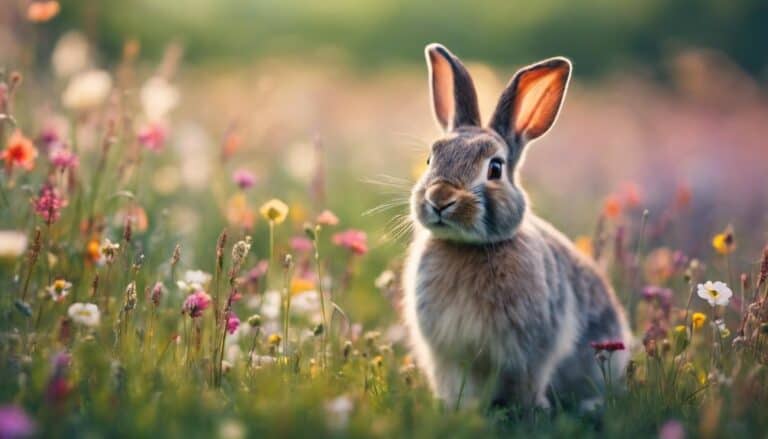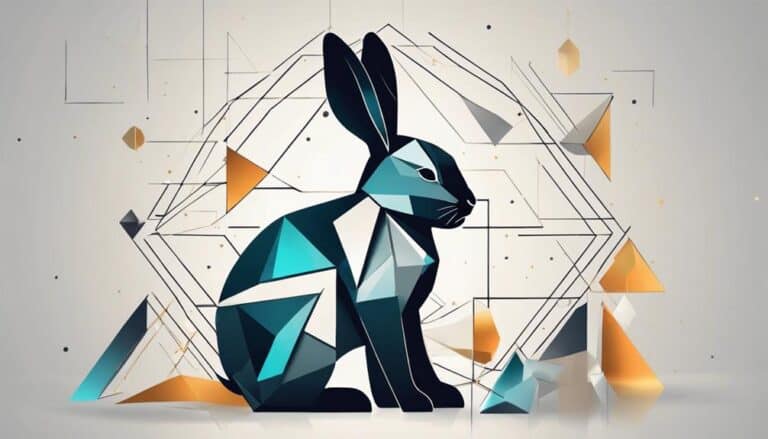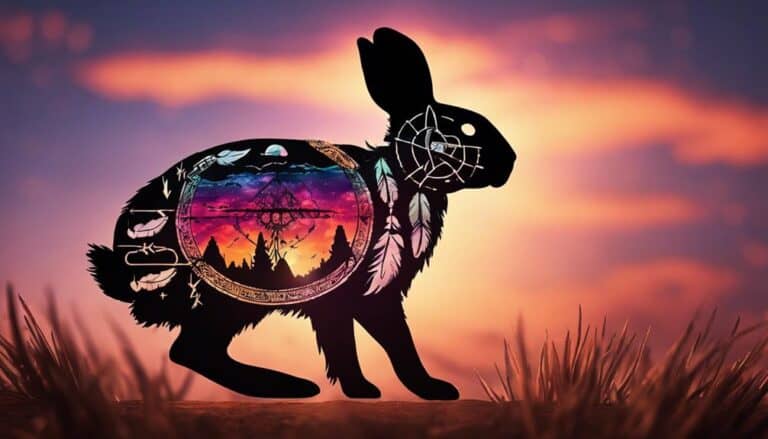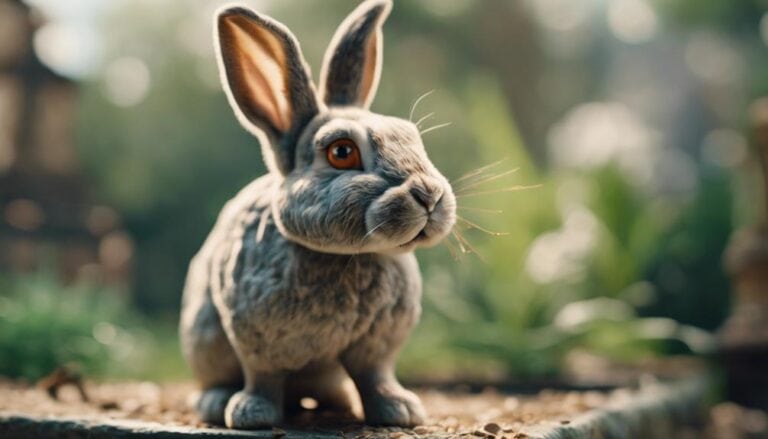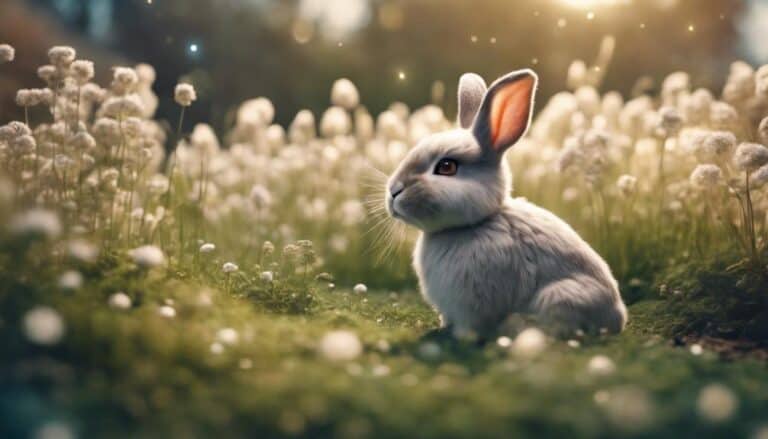Imagine the pages of literature as a lush garden, where bunnies hop gracefully through the fields of prose and poetry, leaving their paw prints on the hearts of readers.
But have you ever pondered why these furry creatures have nestled so deeply into the fabric of storytelling? There's a subtle magic in the way bunnies have woven themselves into the tapestry of literary works, offering layers of meaning that captivate and intrigue both writers and readers alike.
Their presence goes beyond mere fluffiness; it's a doorway to a world where symbolism dances with words, inviting you to explore the hidden depths of their significance.
Contents
- 1 Key Takeaways
- 2 Bunny Symbolism and Cultural Significance
- 3 Historical Depictions in Literature
- 4 Bunnies as Allegorical Figures
- 5 Influence on Poetic Imagery
- 6 Representation in Folklore and Mythology
- 7 Bunnies as Symbols of Innocence
- 8 Evolution of Bunny Motifs
- 9 Impact on Modern Literary Works
- 10 Frequently Asked Questions
- 11 Conclusion
Key Takeaways
- Bunnies symbolize femininity, resilience, and creativity in narratives.
- They embody innocence, vulnerability, and new beginnings in literature.
- Bunny metaphors explore human experiences, emotions, and transformation.
- Bunny imagery in poetry adds tenderness, emotion, and romantic connotations.
Bunny Symbolism and Cultural Significance
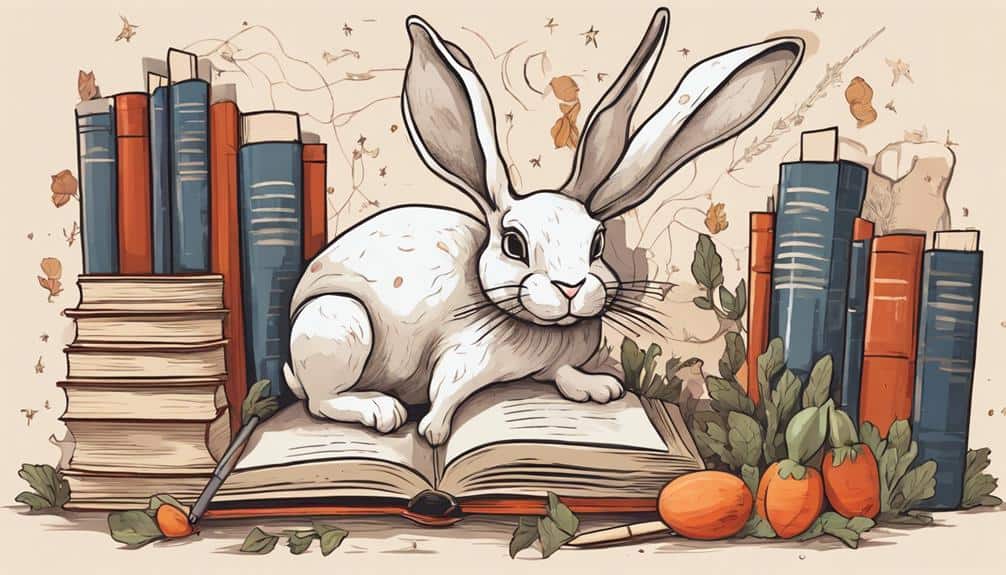
Exploring the rich tapestry of bunny symbolism and cultural significance reveals a profound interconnectedness with themes of femininity, creativity, rebirth, and resilience in literature and poetry.
Bunnies hold a deep-rooted association with fertility, abundance, intelligence, and trickster qualities across various cultures, making them multifaceted symbols in storytelling. Their portrayal symbolizes survival, keen observation, and feminine power, embodying resistance and creativity in narratives.
The bunny's representation transcends mere fluffy imagery, delving into profound meanings that resonate with readers on a subconscious level. In literature, bunnies serve as powerful metaphors for overcoming challenges, adapting to adversity, and harnessing feminine energy. Their trickster qualities add layers of complexity to their character, inviting readers to contemplate the nuanced interplay between innocence and cunning.
Through their portrayal, bunnies become conduits for exploring the intricacies of human experiences, inviting audiences to reflect on the enduring themes of resilience, creativity, and feminine power woven into the fabric of storytelling.
Historical Depictions in Literature
Bunny symbolism's enduring presence in literature is exemplified by the historical depictions that trace back to ancient folklore and mythologies. Bunnies have long served as symbols of fertility, rebirth, and abundance in cultural narratives, resonating with themes of innocence and curiosity.
From the mischievous Peter Rabbit created by Beatrix Potter to the enigmatic White Rabbit in Lewis Carroll's 'Alice's Adventures in Wonderland,' bunnies in literature have embodied various characteristics that captivate readers. These animals aren't merely passive figures but rather active participants in the stories, often representing deeper meanings and emotions that connect with human experiences.
Through their symbolic presence, bunnies evoke a sense of nostalgia, whimsy, and contemplation, inviting readers to explore the nuances of life through the lens of these beloved creatures. Their portrayal in literature reflects a rich tapestry of cultural values, beliefs, and interpretations, highlighting the enduring appeal and significance of bunnies as literary symbols.
Bunnies as Allegorical Figures
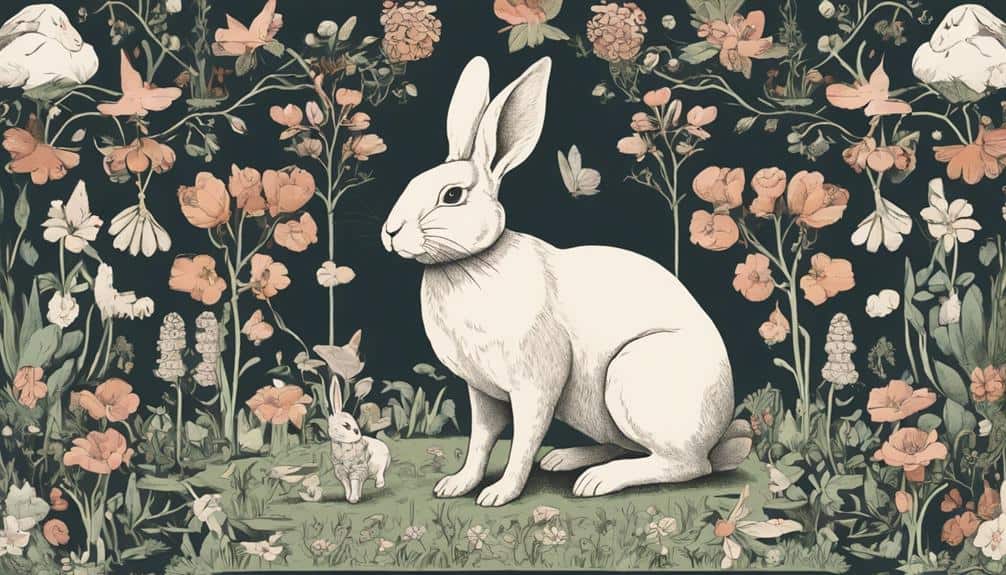
Bunnies, as allegorical figures, carry profound symbolism in literature and poetry, representing themes of innocence and vulnerability. Their metaphorical presence often conveys ideas of fertility, abundance, and new beginnings, enriching the layers of meaning within literary works.
Through the lens of allegory, bunnies offer a versatile symbol that can evoke a myriad of emotions and interpretations, making them powerful tools for exploring complex human experiences in a relatable and engaging manner.
Symbolism in Bunnies
Symbolism within literature and poetry often employs bunnies as allegorical figures, embodying themes of innocence, fertility, and vulnerability. These creatures symbolize more than just their physical presence; they represent concepts like explore, curiosity, playfulness, and exploration.
Through their depiction in various narratives and poems, bunnies offer a lens through which readers can explore into human experiences and emotions. The innocence and vulnerability associated with bunnies evoke a sense of purity and fragility, while their fertility symbolizes growth and abundance.
Their playful and curious nature adds layers of depth to the storytelling, inviting readers to explore themes of transformation and emotion in a unique and engaging way.
Literary Bunny Metaphors
Within the domain of literary works and poetic creations, the subtle presence of these gentle and delicate creatures as allegorical figures offers a profound exploration into complex human emotions and experiences. Bunnies, often depicted as symbols of innocence and vulnerability, carry metaphorical weight in literature and poetry.
Through their portrayal, themes of fertility, rebirth, and transformation are woven into symbolic narratives, providing readers with a lens to contemplate life's cyclical nature. These literary bunny metaphors not only evoke a sense of whimsy and nostalgia but also invite introspection into deeper existential questions.
Influence on Poetic Imagery
Bunnies in poetry serve as powerful symbols, infusing verses with layers of meaning and emotion. These creatures evoke romantic connotations, innocence, and purity, enriching poetic imagery with a sense of nostalgia and grace.
Through their delicate nature, bunnies offer poets a canvas to paint themes of fleeting moments, fragility, and renewal, resonating deeply with readers on an emotional level.
Symbolism in Poems
Imagery of bunnies in poetry captivates readers with its ability to evoke feelings of innocence, vulnerability, and purity, infusing verses with tenderness and nostalgia. When poets use bunny symbolism, it conveys deeper meanings such as:
- Renewal: Bunnies symbolize new beginnings, growth, and the cyclical nature of life.
- Connection: They represent the intertwining of nature, humanity, and the transient beauty of existence.
- Emotion: Rabbit imagery reflects themes of love, loss, freedom, and the fleeting essence of time.
- Complexity: Bunnies serve as gentle metaphors for exploring intricate emotions, memories, and the passage of seasons in a subtle and enchanting manner.
Romantic Connotations
The infusion of romantic connotations through bunny imagery in poetry adds a layer of depth and emotional resonance to the verses, enchanting readers with themes of love, tenderness, and innocence.
Rabbit symbolism in poetic works conveys not only romantic imagery but also evokes feelings of passion, purity, and affection. The whimsical charm associated with bunnies enhances the emotional depth of the poems, creating a sense of nostalgia and warmth that resonates with readers.
Through the beauty of simplicity and grace that bunnies represent, poets can capture the essence of affection and intimacy, allowing their verses to convey a profound sense of connection and vulnerability. Bunnies in literature serve as powerful symbols of love and tenderness, enriching poetic themes with their gentle and heartfelt symbolism.
Innocence and Purity
Enhancing the depth of poetic expression, innocence and purity, embodied by bunnies, infuse verses with a timeless charm and emotional resonance. Bunnies in poetry symbolize more than just cute creatures; they represent deeper themes that resonate with readers on a profound level. Here's a deeper look at the significance of innocence and purity in poetic imagery:
- Bunnies serve as symbols of untainted beauty, evoking a sense of nostalgia and whimsy in poetry.
- The innocence of bunnies in literature adds layers of purity, gentleness, and vulnerability to the emotional impact of the works.
- Bunnies symbolize the untouched beauty of the natural world, reflecting simplicity and unspoiled grace.
- Their presence in poetry captures the universal theme of innocence, purity, and the delicate balance of life, enchanting audiences with their inherent charm and grace.
Representation in Folklore and Mythology
Incorporated into diverse cultural narratives, rabbits in folklore and mythology symbolize foundational aspects of fertility, abundance, and femininity. Within the domain of folklore and mythology, rabbits hold a multifaceted symbolic significance that transcends geographical boundaries.
Often embodying the trickster archetype, these creatures are associated with intelligence, resilience, and adaptability. Their portrayal as tricksters underscores their ability to navigate challenging situations with cunning and wit, making them revered figures in storytelling traditions worldwide.
Additionally, rabbits are frequently linked to themes of rebirth, creativity, and spiritual connections, further enhancing their symbolic importance in cultural imagination. Across various mythologies, the enduring presence of rabbits highlights their representation of fertile abundance and the cyclical nature of life.
Their portrayal as creatures of observation and survival adds depth to their symbolic significance, showcasing their integral role in shaping mythological narratives and enriching cultural heritage.
Bunnies as Symbols of Innocence
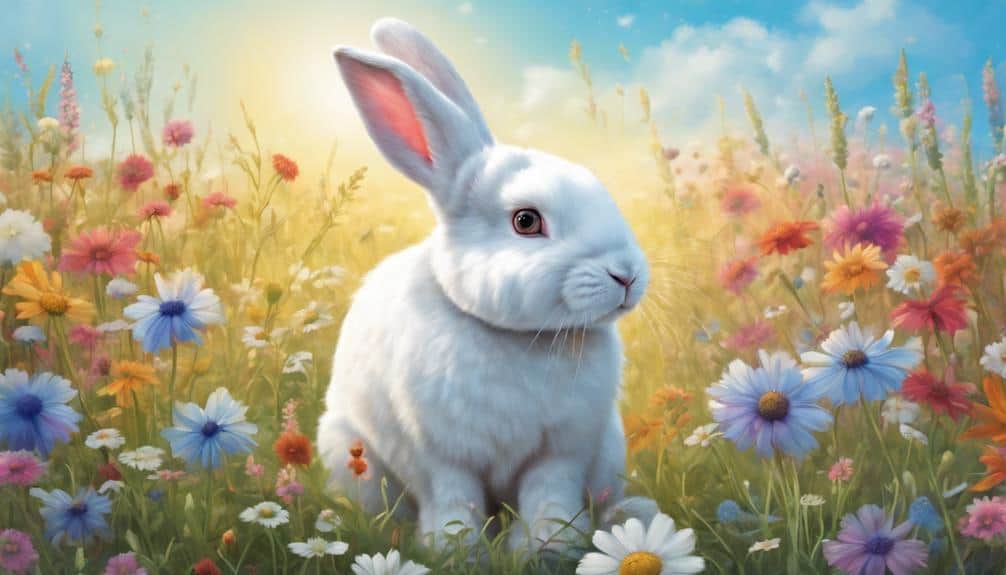
Symbolizing purity and naivety, bunnies in literature and poetry evoke feelings of innocence and simplicity, enriching the thematic depth of creative expressions. When bunnies are used as symbols of innocence, they bring forth a range of deeper meanings:
- Representation of Purity: Bunnies symbolize untouched innocence, reminding readers of the beauty in uncorrupted states.
- Evoke Vulnerability: Their delicate nature portrays vulnerability, highlighting the fragility of innocence in the face of harsh realities.
- Convey Simplicity: Through bunnies, authors convey the simplicity of innocence, emphasizing the uncomplicated aspects of a pure heart.
- Enhance Charm and Beauty: The charm and beauty of bunnies enhance the portrayal of innocence, making it enchanting and enchanting for the audience.
In literature and poetry, bunnies serve as powerful symbols, encapsulating the essence of innocence, purity, and simplicity. Their presence adds a touch of sweetness and beauty, reminding us of the purity that exists in the world.
Evolution of Bunny Motifs
The evolution of bunny motifs in literature and poetry showcases a dynamic shift in how these symbols have adapted and resonated across different cultural contexts and time periods. From ancient mythological symbolism to modern literary representations, bunny motifs have transformed, reflecting changing societal values and perspectives. One notable example is Beatrix Potter's creation of Peter Rabbit, a rabbit character that embodies innocence and curiosity, resonating with audiences of all ages.
Throughout literary history, bunnies have symbolized themes of vulnerability, innocence, and the passage of time in poetic narratives. These symbols add layers of depth and emotion to creative works, capturing the essence of nature, femininity, playfulness, and introspection. The evolution of bunny motifs highlights their enduring appeal and their ability to convey complex emotions through simple yet profound symbolism. As societal values continue to change, bunnies in literature and poetry remain versatile symbols that embody themes cherished by many.
Impact on Modern Literary Works
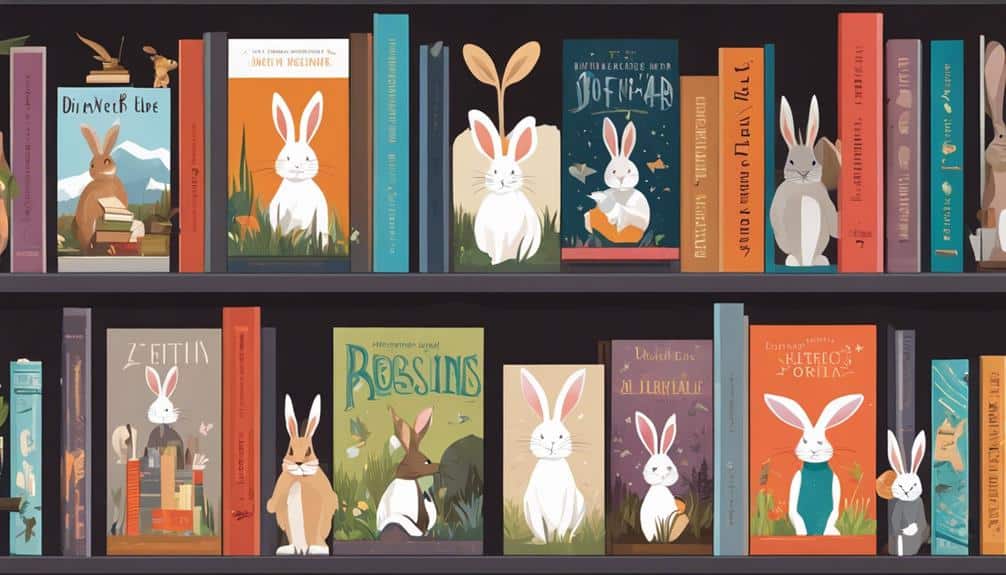
Rabbits in modern literary works serve as powerful symbols, embodying resistance, survival, and feminine power with remarkable depth and complexity.
- Rabbit symbolism in literature reflects themes of rebirth, regrowth, and empowerment in narratives.
- They embody traits of observation, resilience, and creativity, making them compelling symbols in contemporary literature.
- Authors utilize rabbit motifs to explore complex themes of intelligence, survival, and creativity in their works.
- The presence of rabbits in literature adds depth and symbolism, enriching the storytelling experience for readers.
In contemporary literature, authors like Beatrix Potter with her character Peter Rabbit have elevated the rabbit symbol beyond its fluffy exterior. Through their narratives, rabbits represent not just cute creatures but also resilience, adaptability, and the strength of femininity. The incorporation of rabbit symbolism adds layers of meaning to stories, inviting readers to explore deeper into themes of empowerment, creativity, and the enduring spirit of survival.
Frequently Asked Questions
What Do Rabbits Symbolize in Literature?
In literature, rabbits symbolize innocence and vulnerability, fertility and abundance. They embody luck, prosperity, and speed. Their trickery and cunning reflect fear and danger, while their curiosity and exploration signify playfulness and joy. Transformation and rebirth highlight harmony and balance.
What Is the Symbolism of a Bunny?
In literature and poetry, bunnies symbolize innocence, fertility, luck, and abundance. Their playfulness and vulnerability add charm, while speed and agility reflect agility. Their cuteness embodies renewal and protection, bringing whimsy and magic to narratives.
What Is Significant About Rabbits?
In cultural significance, rabbits embody fertility symbolism, folklore connections, and nature imagery. They inspire literary representations with spiritual meanings, symbolic interpretations, and animal totems. Mythical creatures, rabbits symbolize resilience and feminine power through various symbolic motifs.
What Do Rabbits Symbolize in Art?
Rabbits symbolize cultural interpretations, historical meanings, and psychological associations in art. Artists use them to convey various themes like rebirth and fertility. Their visual representations carry symbolic significance, connecting folklore, spirituality, and mythology.
Conclusion
You have explored the enduring presence of bunnies in literature and poetry, uncovering their rich symbolism and cultural significance.
Did you know that rabbits are mentioned over 1,000 times in English literature, showcasing their diverse roles as allegorical figures, symbols of innocence, and embodiments of resilience?
This statistic highlights the profound impact of bunnies in shaping narratives and conveying deeper meanings that resonate with readers across time and cultures.

